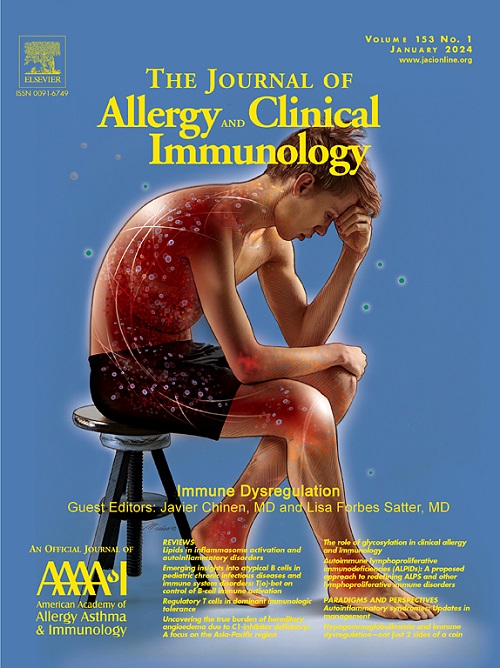dupilumab诱导的通过TIM-3-TGF-β1反馈回路抑制骨髓树突状细胞功能治疗特应性皮炎。
IF 11.4
1区 医学
Q1 ALLERGY
引用次数: 0
摘要
尽管临床试验已经证明了dupilumab的有效性和安全性,但其对树突状细胞(DCs)的影响尚不清楚。TIM-3已成为各种炎症性疾病免疫反应的重要调节因子。了解TIM-3与特应性皮炎(AD)中2型炎症反应之间的相互作用可以为dupilumab疗效的机制提供有价值的见解。目的探讨TIM-3是否诱导dc的免疫调节,并确定其在dupilumab治疗中的作用。方法采用单细胞技术筛选免疫检查点表达图谱。采用αIL-4/IL-13单克隆抗体对小鼠进行治疗,模拟杜匹单抗治疗的治疗效果。用αTim-3单克隆抗体研究免疫检查点Tim-3的功能。最后,在dupilumab治疗前后16周(n=24)收集AD患者外周血单个核细胞(PBMCs),以验证小鼠实验中观察到的结果。此外,在治疗前(n=8)和治疗后(n=5)收集AD皮肤病变,以进一步验证。为了验证TGF-β1和半乳糖凝集素-9的治疗作用,我们还从未治疗的AD患者(n=21)中收集PBMCs,并进行体外刺激实验。结果dupilumab通过诱导髓系dc中TGF-β1的分泌上调免疫检查点HAVCR2(编码TIM-3)。有趣的是,TIM-3也促进TGF-β1的分泌,形成一个正反馈循环。发现这一过程促进髓细胞DC凋亡,导致观察到的髓细胞DC数量减少,并可能增强dupilumab的治疗效果。dupilumab治疗前后AD患者的pbmc和皮肤病变分析显示,dupilumab显著升高TIM-3水平,这与髓性DC比例降低和髓性DC功能抑制相关。在体外用TGF-β1或半乳糖凝集素-9刺激PBMCs同样显示出它们抑制AD中髓系dc功能的能力,提示潜在的治疗作用。结论dupilumab通过诱导TIM-3表达抑制髓系DCs功能改善AD症状,TGF-β1或半凝集素-9治疗可增强上述作用,表明靶向TGF-β1/半凝集素-9-TIM-3轴治疗AD具有潜力。本文章由计算机程序翻译,如有差异,请以英文原文为准。
Dupilumab-induced inhibition of myeloid dendritic cells function via TIM-3-TGF-β1 feedback loop in treatment of atopic dermatitis.
BACKGROUND
Although clinical trials have demonstrated both the efficacy and safety of dupilumab, its impact on dendritic cells (DCs) remains unclear. TIM-3 has emerged as crucial regulators of immune responses in various inflammatory diseases. Understanding the interplay between TIM-3 and the type 2 inflammatory response in atopic dermatitis (AD) could provide valuable insights into the mechanisms underlying the efficacy of dupilumab.
OBJECTIVE
To investigate whether TIM-3 induce immune modulation of DCs and determine its role in dupilumab therapy.
METHODS
Using single-cell technology to screen for the expression landscape of immune checkpoints. Employing αIL-4/IL-13 monoclonal antibody treatment in mice to simulate the therapeutic effects of dupilumab treatment. Investigating the function of the immune checkpoint Tim-3 with αTim-3 monoclonal antibody. Finally, peripheral blood mononuclear cells (PBMCs) were collected from AD patients 16 weeks before and after dupilumab treatment (n=24) to validate the findings observed in the mouse experiments. Additionally, AD skin lesions were collected before treatment (n=8) and after treatment (n=5) for further validation. To verify the therapeutic effects of TGF-β1 and Galectin-9, we also collected PBMCs from untreated AD patients (n=21) and conducted in vitro stimulation experiments.
RESULTS
Dupilumab upregulates the immune checkpoint HAVCR2 (encoding TIM-3) by inducing the secretion of TGF-β1 in myeloid DCs. Interestingly, TIM-3 also promotes the secretion of TGF-β1, thus forming a positive feedback loop. This process was found to promote myeloid DC apoptosis, contributing to the observed decrease in myeloid DC numbers and potentially enhancing the therapeutic effects of dupilumab. The analyses of PBMCs and skin lesions from AD patients before and after dupilumab treatment showed dupilumab significantly elevated the levels of TIM-3, which correlated with a reduced proportion of myeloid DCs and suppressed myeloid DC function. In vitro stimulation of PBMCs with TGF-β1 or Galectin-9 similarly revealed their ability to inhibit myeloid DCs function in AD, suggesting potential therapeutic effects.
CONCLUSION
Dupilumab improves the symptoms of AD by inducing the expression of TIM-3 to suppress myeloid DCs function, treatment with the TGF-β1 or Galectin-9 enhanced these effects, demonstrating the therapeutic potential of targeting the TGF-β1/ Galectin-9-TIM-3 axis in AD.
求助全文
通过发布文献求助,成功后即可免费获取论文全文。
去求助
来源期刊
CiteScore
25.90
自引率
7.70%
发文量
1302
审稿时长
38 days
期刊介绍:
The Journal of Allergy and Clinical Immunology is a prestigious publication that features groundbreaking research in the fields of Allergy, Asthma, and Immunology. This influential journal publishes high-impact research papers that explore various topics, including asthma, food allergy, allergic rhinitis, atopic dermatitis, primary immune deficiencies, occupational and environmental allergy, and other allergic and immunologic diseases. The articles not only report on clinical trials and mechanistic studies but also provide insights into novel therapies, underlying mechanisms, and important discoveries that contribute to our understanding of these diseases. By sharing this valuable information, the journal aims to enhance the diagnosis and management of patients in the future.

 求助内容:
求助内容: 应助结果提醒方式:
应助结果提醒方式:


